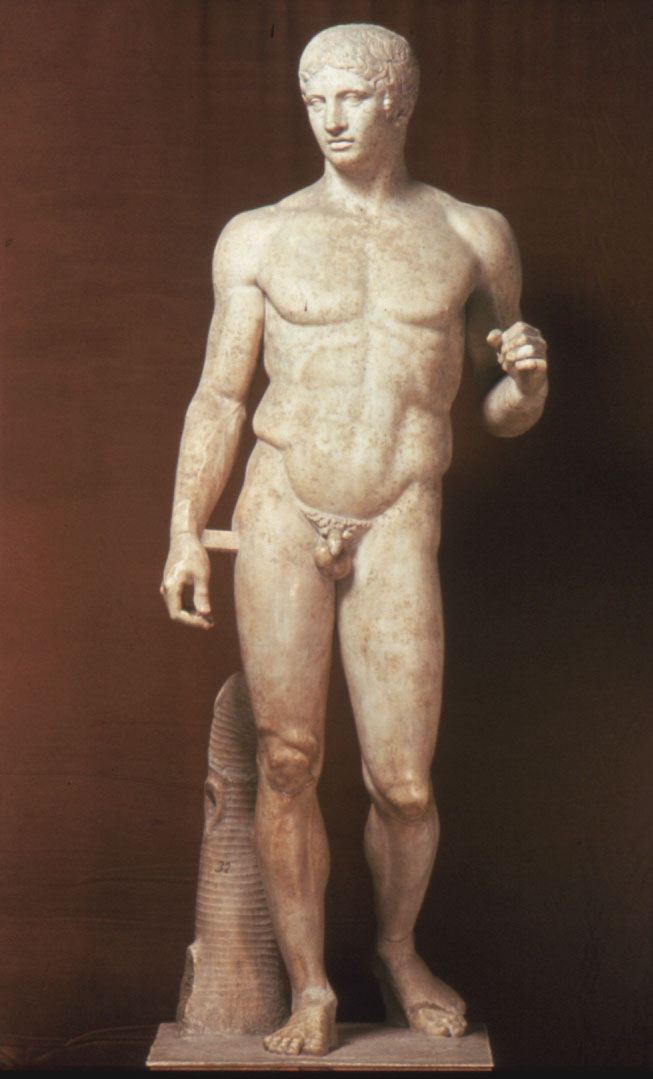In early Greece, the serene, harmonious Classical style pervaded the artistic scene:
 Polykleitos, "Spear-bearer" (Doryphoros), original dated c. 450-440 BC.
Polykleitos, "Spear-bearer" (Doryphoros), original dated c. 450-440 BC.
However, a short time later, the calm Classical style was disrupted by a taste for more dramatic, diagonal compositions in the Hellenistic period. In addition, relief sculptures were carved more deeply (some sculptures were practically in-the-round, almost jumping off of the relief wall) so that intense shadows could be cast:
 Athena Battling Alkyoneos, Detail of the Gigantomachy Freize from the Altar of Zeus (Pergamon, Turkey, c. 175 BC).
Athena Battling Alkyoneos, Detail of the Gigantomachy Freize from the Altar of Zeus (Pergamon, Turkey, c. 175 BC).
The cycle between serenity and drama began again centuries later, when the Classical style became revived during the Renaissance:
 Michelangelo, David, 1501-04
Michelangelo, David, 1501-04
And only a century later, the Baroque period began as the artistic scene once again favored diagonal, dramatic compositions and subject matter:
 Bernini, David, 1623
Bernini, David, 1623The Romantic movement began about the same time and can be interpreted as a continuation of this cycle. In a way, the Romantics reacted against Neoclassicism by favoring drama and emotion over the serenity. This painting by Géricault focuses on dramatic subject matter by depicting a real-life event of shipwrecked passengers that were on the boat "Medusa." A shortage of lifeboats caused 150 passengers to build a raft, and survivors resorted to cannibalism in order to stay alive on the open sea. (You can read more of the story here.) Can you see how this subject matter is dramatic? To heighten the drama, Gericault depicted an emotional moment when the survivors spot their rescue ship in the distance. Géricault even follows the same dramatic diagonal compositions that were favored in earlier dramatic styles:
 Géricault, Raft of the "Medusa", 1818-19
Géricault, Raft of the "Medusa", 1818-19
Since the Neoclassical/Romantic periods, the artistic continuum really hasn't seen another revival of the serene/dramatic styles. There have been some slight interest in traditional subject matter, such as the Regionalism movement (think of American Gothic). I guess Regionalism could be considered a continuation of serenity and tradition, if one is willing to categorize abstractionism (the style the Regionalists rejected) as dramatic. Hmm.
I'm curious to see if art will ever return back to this cycle. Since the 19th and 20th centuries, art has just exploded into different types of media and styles. Have we left traditional cycles altogether? It is interesting to think about what art will be like in a hundred years or so.
What do you think about the future of art? Have you observed any other types of artistic cycles besides this one?
I'm curious to see if art will ever return back to this cycle. Since the 19th and 20th centuries, art has just exploded into different types of media and styles. Have we left traditional cycles altogether? It is interesting to think about what art will be like in a hundred years or so.
What do you think about the future of art? Have you observed any other types of artistic cycles besides this one?
